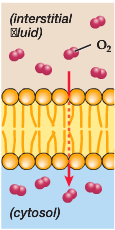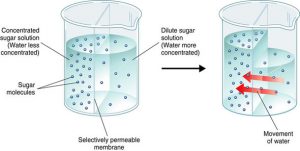Passive Transport
Passive Transport of Molecules Across a Membrane
The movement of molecules across the plasma membrane can occur without the expenditure of energy. This is referred to as ‘passive’ transport. Passive transport across the membrane can occur via several mechanisms:
- Simple Diffusion
- Facilitated Diffusion
- Osmosis
We will now explore each of these mechanisms in turn…
Passive Transport of Molecules Across a Membrane
The movement of molecules across the plasma membrane can occur without the expenditure of energy through simple diffusion, facilitated diffusion or osmosis.
Simple Diffusion
Some molecules that are either small enough or lipid-soluble are capable of crossing the phospholipid bilayer of the membrane without trouble. These molecules follow the established concentration gradient to cross the plasma membrane, moving from the side (or area) of the membrane which has a higher concentration toward the opposite side of the membrane with a lower concentration

Facilitated Diffusion
Molecules that are simply too large, have an electrical charge or are lipid-insoluble cannot pass directly through the plasma membrane. For these molecules, their movement across the membrane will require some assistance.
While the overall movement of the molecules still follows the established concentration gradient (movement will occur from area of high concentration toward area of lower concentration), movement must occur through a membrane protein specialized at facilitating the movement of these molecules.
Osmosis
Unlike diffusion, osmosis represents the movement of water (solvent) across a semi-permeable membrane. It is important to realize that concentration gradients still play a role in determining the direction of water movement across the membrane.

When a solute is dissolved in a solvent like water, the water molecules are displaced to make room for the solute. Therefore, when comparing two solutions, the one with the higher solute concentration will have essentially a ‘lower’ concentration of water molecules. If these two solutions are separated by a membrane (assuming the solute cannot diffuse across the membrane), then the water molecules will tend to move according to their concentration gradient. In this case, water will tend to move from the area with more free water molecules (lower solute concentration) toward the area with fewer free water molecules (higher solute concentration).
The fundamental principles of osmosis are:
- Osmosis is the movement across a selectively permeable membrane by simple or facilitated diffusion
- Solutes dissolved in a solvent will reduce the amount of ‘free’ water molecules present in a solution
- The movement of water in osmosis will always be toward areas of low solute concentration (higher water concentration) toward areas of high solute concentration (lower water concentration)
Summary
The movement of molecules across the plasma membrane can occur without the expenditure of energy. This is referred to as ‘passive’ transport. Passive transport across the membrane can occur via several mechanisms:
- Simple Diffusion – passage of small molecules
- Facilitated Diffusion – passage of large molecules
- Osmosis – passage of water